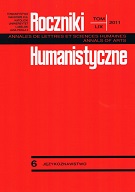Ironia, autoironia, sarkazm - trzy odmienne funkcjonalnie zdarzenia komunikacyjne
Irony, Self-Mockery, Sarcasm - the Three Different Communicative Occurrences
Author(s): Eliza GrzelakSubject(s): Language and Literature Studies
Published by: Towarzystwo Naukowe KUL & Katolicki Uniwersytet Lubelski Jana Pawła II
Keywords: irony; self-mockery; sarcasm; communication; intention of transmission; communicative occurrence
Summary/Abstract: In the article, the author presents opinions of literature theorists, experts on rhetoric and culture, literature historians with regard to irony. She shows ways of defining irony, forms of ironic discourse, focuses on the overtness degree of ironic discourse among other things. In this background she depicts problematic, in her opinion, positions to self-mockery and sarcasm. The author cast a doubt on thesis that self-mockery is irony with a different object of ironic description and that sarcasm is strong irony. In the last part of the text the author draws attention to the fact that if treat irony, selfmockery and sarcasm as communicative occurrences then the differences among them can be seen in their sender-recipient context and functionality. Finally, she proves that irony is the tool of attack, self-mockery – defence, sarcasm indicates surrender. The author finds particularly interesting the fact that, even though these three forms of transmission are exceptionally complex tools of social communication, they are willingly and fortunately used by users of public discourse. According to that, she proves the thesis of anthropocentric genesis of irony. This form of presentation of the position is deep in us and, by use of various types of signs, we let it come out for a while.
Journal: Roczniki Humanistyczne
- Issue Year: 59/2011
- Issue No: 06
- Page Range: 75-87
- Page Count: 13
- Language: Polish

